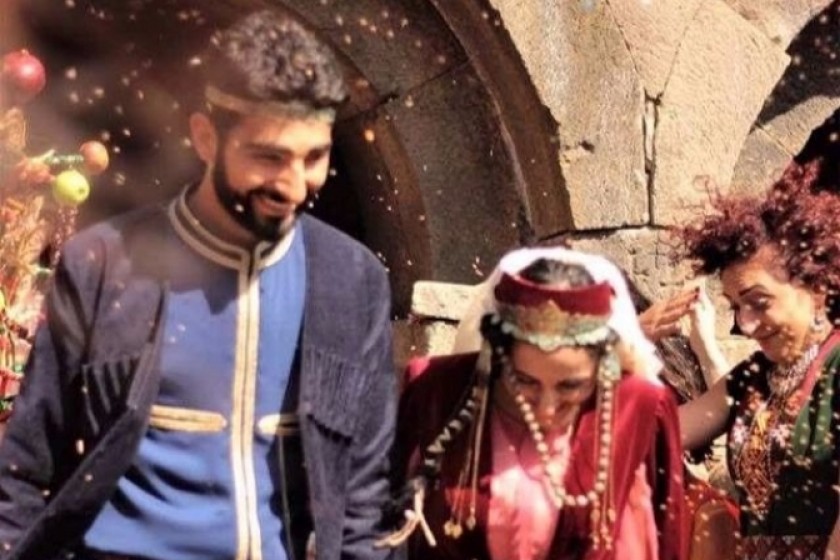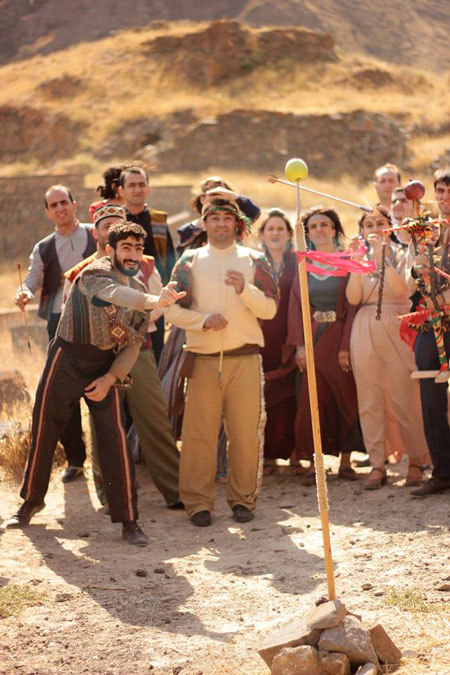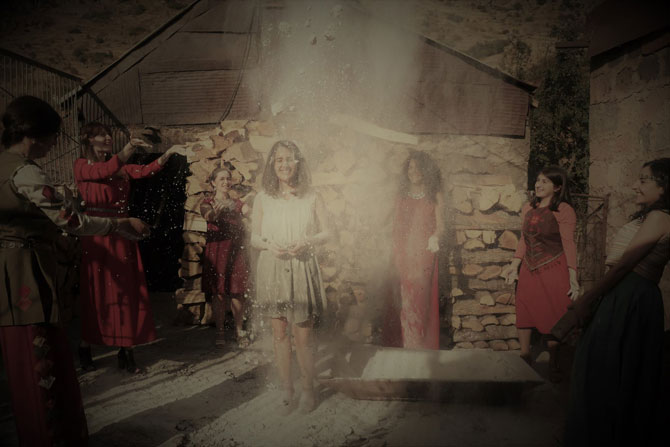
Preserving Wedding Traditions: Armenia’s Tonir Project Transforms a Village into an Exclusive Bridal Destination with all the Cultural Attributes
By Rimma Ananian
A traditional wedding sounds great, right? And what about a traditional wedding ina village designed solely for that purpose?
In many countries, the idea of having an entire village as a wedding setting is not new. In the past, people did not select the invitees from long lists of friends and family, then ask“the chosen ones”to RSVP via e-mail.
Instead, people invited all the inhabitants of their home village, and sometimes even of the surrounding villages, to the celebration. The families of the newlyweds threw feasts for 200-300 peopleminimum. Celebrations lasted for at least three days.
As crazy and cumbersome of a process as it sounds, this was usual for the villagers. They even had special traditional dishes, songs, and games in specific order,for such occasions.Notably, for many eastern countries, such as India or some Arab countries, it is still common to celebrate weddings several days long with a guest list exceeding a hundred.
Today, the idea of a wedding village has been transformed into justa fancy wedding destination. The famous ones in Europe are Los Castillejos in Spain, Titignano in Italy, and Castelnau des Fieumarcon in France. There is also one in Russia, called Krasnoe-na-Volge, located in Kostroma Oblast.
However, these did not inspire the founders of Tonir Wedding Village in Armenia; love for each other and forArmenian history did.
Tonir Wedding Village is a resourceful cultural startup, founded by a young Armenian couple — Hayk Yeranosyan and Sirarpi Leraneh Khojabaghyan —who came up with the idea for their own marriage. Because that’s what you do when you can’t find the type of setting that you need: you create your own, and make it a long-term project, right?

Tonir is a venue for traditional Armenian weddings, which has a goal to preserve the culture of these weddings by carrying out the traditions of these weddings in the age of bridal bouquets with go-pro cameras and wedding cakes with light projections.
Tonirwon the first place at theCreative Armenia Business Challengeof 2017. At first, Hayk and Sirarpi were very skeptical of their chances of success because most startups that have won contests in Armenia were from the IT sector.
“We liked our idea, but we were afraid that the public wouldn’t. Even our parents told us we have to find some ‘real business’ to get busy with,” Hayk admits.
“By the finale of the contest, people from other contestant startups approached us and said that they want us to win,” Hayk recalls, laughing.
The victory gave them media coverage and AMD 500,000 AMD (approx. $1,046) for the future development of their startup. Sirarpi and Hayk have a long-term plan, which is to have one Tonir in every marz (province) of Armenia, so that Armenian couples from all around the world can celebrate their love with traditional weddings.
The intention to create a network is also the reason they did not call the startup by the name of the real village it will be situated in. Theychose Tonir because, when written in the Latin alphabet, it can be read both like the Armenian place to make lavash (Armenian bread), and like the imperative for the word “celebrate”, and that’s what Toniris about.
The first Tonir will be located in Vaghatin village. Lost in the mountainous landscape of SyunikMarz, the most southern region of Armenia, Vaghatinis home to a little over 700 people, and to a picturesque tenth century monastery complex called Vorotnavank.
The couple chose this village because they both have roots there. Because of financial difficulties the founders face, Vaghatin is still the process of being transformed into the kind of village that the founders envision.
According to Hayk, none of the Armenian ministries has been active in supporting this innovative idea, although the couple contacted some of them even before their wedding. Hayk and Sirarpi hoped to get financial support from the government so that they could shoot a promotional video of their startup that they also want to make an official cultural program of Armenia. The plan was to do the promo video during their own wedding, so that they wouldn’t have to spend extra money on staging an entire three-day-long feast with 300 people for the sole purpose of video recording.
For their wedding, Hayk and Sirarpi transformed three of Vaghatin’s uninhabited dwellings into those of groom’s, bride’s, and qavor’s (godfather’s) places. The wedding lasted three days — from August 25 to 27.
On the first day, all the unmarried women in the bride’s house did the aliurmagheq (the sifting of the flour). Each had their personal sieve. The girl to find a ring on the bottom of her sieve would be the next to get married.
Meanwhile, the men in the groom’s house didthe yezmorteq (the ritual killing of a bullock).For hinadreq (painting the bride’s hands with henna), Sirarpi and the women moved to her real house, located close to the village.

“The process of painting the hands of a bride-to-be with henna is actually an Armenian tradition,” Hayk says proudly. Armenians, unlike, for example, Indians, did not do all the flowers and patterns, but instead paintedjust the bride’s palms toguarantee her fertility and happiness in the married life.Every action in both houses was accompanied with singing, dancing, and laughter.
The traditional Armenian costumes (taraz) that the participants wore suited the village setting ideally. The rituals were performed as if the participants knew and practiced them their entire life. This was due to Hayk’s and Sirarpi’s extensive research, done prior to their Big Day (or days, rather).
Three major events were divided between the remaining two days: the act of the groom coming to the bride’s house to take her to his house, the wedding in the church, and the feast.
These processes, too, are saturated with many games and rituals. Just to mention a few: to take the bride home, the groom has to move a big stone that stands on his way to the house of his beloved one, while the bride’s relatives have to be attentive not to let the groom’s relatives steal the hens of the bride’s parents. To decide the godfather of the first child of the newlyweds, the makars, also called azabs (groom’s unmarried male friends) have to hit an apple with an arrow, and the first one to succeed will be the qavor.
The newlyweds had to rent both the place and the tarazs, because although theydid a fundraising on Indiegogo,there were still not enough resources to redesign Vaghatin completely. With $4,000 as a target sum, they hoped that money would help them buy the costumes, create the decorations for the execution of all corresponding traditions, and make the promo video for their startup.
They were also going to contribute money to cleaning up the territory of the Vorotnavank church complex. However, the target was not hit, and so they ended up doing a lot of DIY, renting, and having their moviemaker friends do the shooting. Even so, they love the end result, and are not discouraged by the lack of money at all. They did what they wanted for their wedding: got married in Vorotnavank, had the feast in Vaghatin, and shot the video for their Facebook page.
Currently, Tonir Wedding Village has numerous orders. Although Vaghatin does not completely correspond to the vision of the founders, they are going there with the help of their parents, friends, and the villagers themselves.Government agencies are expected to respond soon, too.
The villagers are very enthusiastic about the project, because it will also contribute to the development of the region and solve the unemployment and poverty problems facedby locals.
Hayk and Sirarpi have also recently presented Tonir in the framework of the Armenia-Diaspora Conference. “After my speech, many diasporans approached me to express their approval of our idea,” Hayk says, smiling,
“One young man from Austria even told me that he plans to get married next year, and that he is willing to organize the wedding in Tonir.”
Hayk and Sirarpi plan to repair the houses of Vaghatin soon, and transform the abandoned ones into locations for wedding traditions. They also want to hire genealogists who would help the newlyweds trace their ancestry.
“Wedding traditions of Armenians differ from region to region, and we want to be as accurate with the rituals and dresses as we can,” Hayk says. Moreover, they are eager to have each wedding video recorded, so they hope to hire a movie crew.
For now, they have made another promotional video from what they had recorded during the weddings they had organized.
Rimma Ananian is a senior student at the American University of Armenia majoring in English and Communications. She describes herself as a 20-year-old aspiring politician, and a huge advocate for the development of her motherland.
 Videos
Videos Photos
Photos




Comments (2)
Write a comment